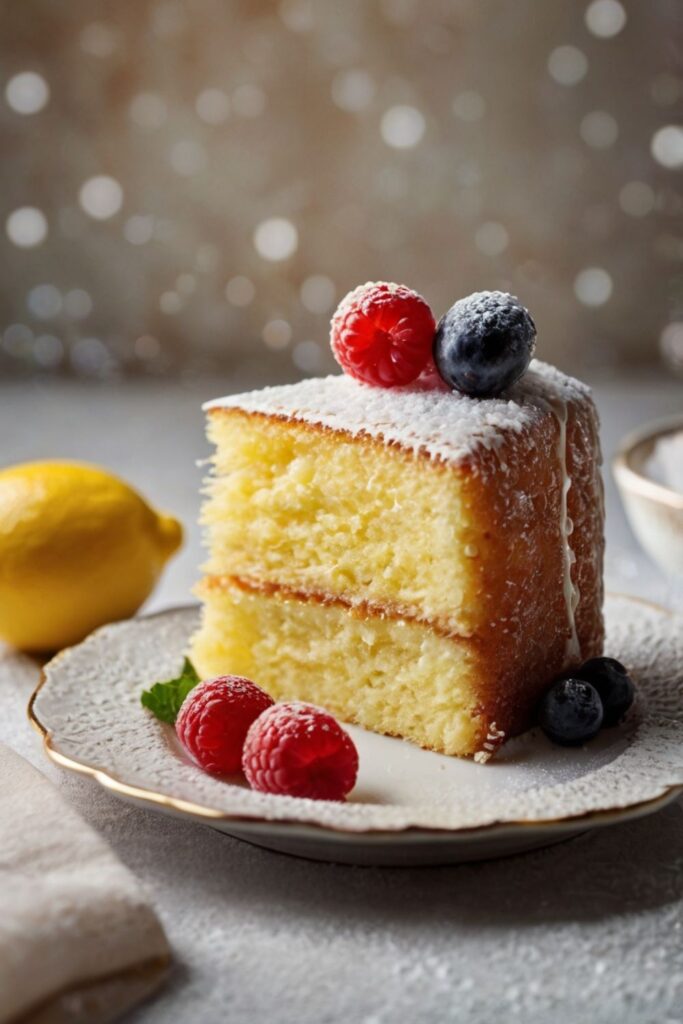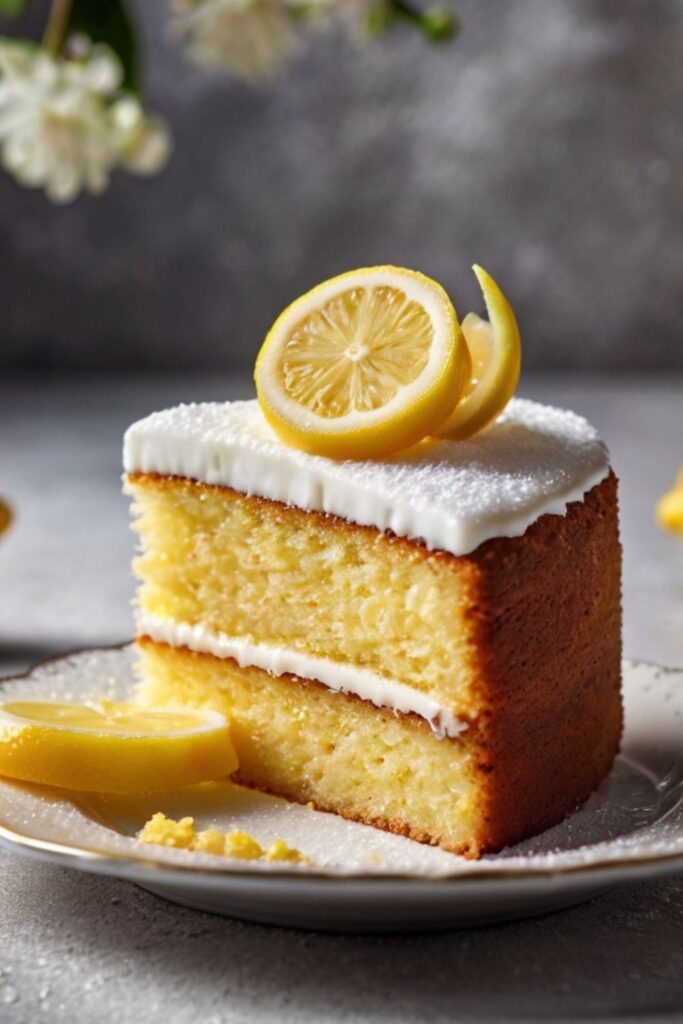Have you ever bitten into a dessert and felt your taste buds wake up? That’s exactly what Lemon Cake – Sweet Meets Zesty delivers. It’s not just a cake, it’s a celebration of bright citrus joy wrapped in soft, golden sweetness. Imagine the bold zing of fresh lemon meeting the gentle hug of sugar and butter. Pure magic.
I first made this Lemon Cake on a rainy afternoon. One bite and the day felt lighter, sunnier. The scent of lemon zest swirling through the kitchen, the warm crumb melting on the tongue… it instantly became a favorite. And it’s stayed that way.
In this post, I’ll walk you through every step to make your own Lemon Cake. You’ll learn the tricks to getting it moist, fluffy, and bursting with real lemon flavor. We’ll talk ingredients, methods, and those little secrets that take it from good to unforgettable.
Craving something that’s fresh, bold, and soul satisfying? This is it. Let’s turn simple ingredients into a zesty showstopper your friends and family will request again and again. Ready to bake some joy? Let’s dive in.
Ingredients & Smart Swaps
Here’s what you’re gonna need, listed in the order you’ll actually use them:
For the cake:
- 2½ cups all purpose flour
- 1½ cups granulated sugar
- ½ cup unsalted butter, softened
- ¼ cup sour cream (here’s that secret ingredient!)
- 3 large eggs, room temperature
- 1 cup whole milk
- Zest of 3 large lemons
- ¼ cup fresh lemon juice
- 2 teaspoons baking powder
- ½ teaspoon salt
- 1 teaspoon vanilla extract
For the glaze:
- 1½ cups powdered sugar
- ⅓ cup fresh lemon juice
- 2 tablespoons melted butter
- Pinch of salt
Now, let’s talk swaps because life happens and grocery stores don’t always cooperate.
Can’t do dairy? Substitute the butter with vegan butter (make sure it’s the kind that’s good for baking), swap the milk for oat milk, and use coconut cream instead of sour cream. The texture won’t be identical, but it’ll still be delicious.
No sour cream on hand? Greek yogurt works beautifully. So does buttermilk if you reduce the regular milk to ¾ cup. In a real pinch, you can make “sour milk” by adding a tablespoon of white vinegar to regular milk and letting it sit for five minutes.
Here’s something most people don’t know: the type of lemon matters more than you’d think. Meyer lemons are sweeter and less acidic, they’re gorgeous if you can find them. Regular supermarket lemons work perfectly fine, but if they feel light for their size, they’re probably dry inside. Give ’em a gentle squeeze; you want ones that give just slightly.
Always zest before you juice. Trust me on this one. Once you’ve cut into that lemon, getting clean zest becomes a wrestling match you’re gonna lose.
Step by Step Magic: Crafting the Perfect Lemon Cake

Prep Like a Pro
Preheat your oven to 350°F. Grease a 9×13 inch pan or two 9 inch round pans with butter. Dust with flour. Don’t skip this step, nothing’s sadder than gorgeous cake stuck in the pan.
Room temperature ingredients mix better. If you forgot to take your eggs and butter out early (we’ve all been there), place the eggs in warm water for ten minutes. Cut your butter into small pieces.
Cream the Magic
In a large bowl, cream that softened butter with the sugar until it’s light and fluffy. This takes longer than you think about four minutes with an electric mixer. The mixture should look almost white and increase in volume. This is where we’re building the cake’s structure, so don’t rush it.
Add the sour cream and vanilla. Beat until combined. Here’s where that sour cream works its magic , it adds richness and helps create the most tender crumb you’ve ever experienced.
The Egg Dance
Add eggs one at a time, beating well after each addition. If the mixture looks like it’s curdling, don’t panic. Add a tablespoon of flour and keep mixing. It’ll come together.
This is when I usually add the lemon zest. The oils from the zest need time to infuse into the batter, and mixing releases even more of that bright, citrusy essence.
The Gentle Fold
In a separate bowl, whisk together flour, baking powder, and salt. Now comes the crucial part: we’re gonna alternate adding the dry ingredients and the milk, starting and ending with the flour mixture.
Add about a third of the flour mixture, mix just until combined. Pour in half the milk, mix gently. Another third of flour, the rest of the milk, then the final flour. Stop mixing the moment you don’t see dry flour streaks.
Overmixing develops the gluten, and that’s how you end up with a tough cake instead of the tender masterpiece we’re after.
The Lemon Juice Surprise
Here’s where things get interesting. Slowly drizzle in that fresh lemon juice while folding gently. The acid reacts with the baking powder for extra lift, plus it brightens every single bite.
Pour the batter into your prepared pan(s). Give the pan a gentle tap on the counter to release air bubbles.
The Bake
Bake for 28-35 minutes (less for round pans, more for the rectangle). The cake is done when a toothpick comes out with just moist crumbs.
Don’t open the oven door for the first 25 minutes. I know it’s tempting, but cool air can flatten your cake.
The Glaze Glory
While the cake cools for about ten minutes, make your glaze. Whisk together powdered sugar, lemon juice, melted butter, and that pinch of salt. It should be pourable but not too thin, think thick cream consistency.
Here’s the secret: poke holes all over the warm cake with a skewer, then pour the glaze over top. The warm cake will drink up some of that glaze, creating pockets of intense lemon flavor throughout.
The Science Behind the Sizzle

Let’s talk about why this recipe works so beautifully. That sour cream isn’t just there for flavor, it’s an acid that tenderizes the gluten proteins in flour. It’s like having a built in tenderizer that also adds richness.
The combination of baking powder and acidic ingredients (sour cream, lemon juice) creates a double lift action. The baking powder gives immediate rise when it hits moisture, then the acid reaction provides even more lift in the oven. That’s why we get such a light, airy texture.
Creaming butter and sugar properly incorporates air bubbles that expand during baking. Those four minutes of beating aren’t just busy work, they’re literally building the cake’s structure. Under cream and your cake will be dense. Over cream and the structure can collapse.
The alternating wet and dry ingredients technique prevents overmixing. Starting with flour creates a protective coating around the butter mixture, so when we add liquid, it incorporates more gently. Ending with flour ensures everything’s evenly distributed without developing tough gluten strands.
Temperature matters more than most home bakers realize. Room temperature ingredients emulsify better, creating a smoother batter and more even texture. Cold ingredients can cause the butter to seize up, leading to a lumpy mess that never quite comes together properly.
Making It Beautiful & Delicious
Let’s be honest, this cake is gorgeous just as it is. That glossy lemon glaze catches light beautifully, and the golden color screams sunshine and happiness.
But if you wanna take it up a notch, try these simple touches: fresh berries scattered on top add color and complement the citrus perfectly. A light dusting of powdered sugar through a fine mesh sieve creates an elegant finish. Candied lemon slices (thin slices simmered in simple syrup) make stunning garnishes.
For serving, this cake plays well with others. A dollop of fresh whipped cream balances the bright acidity. Vanilla ice cream turns it into an instant sundae. Fresh strawberries or blueberries add natural sweetness and beautiful color contrast.
If you’re feeling fancy, serve thin slices with a cup of Earl Grey tea, the bergamot and lemon are best friends. For wine lovers, a glass of Riesling or Prosecco echoes the citrus notes beautifully.
Photography tip: natural light is your friend with this cake. That golden color looks incredible near a window, and the glossy glaze reflects light in the most appetizing way.
Wrapping It Up with a Zesty Lemon Cake Finale

This lemon cake recipe isn’t just about mixing ingredients together, it’s about creating something that brings joy to every single bite. The sweet meets zesty balance we’ve achieved here is what makes people close their eyes and smile when they taste it.
The real magic happens in those little details: properly creamed butter, room temperature ingredients, that secret sour cream, and the double hit of lemon zest and juice. These aren’t just steps in a recipe. They’re the difference between good and unforgettable.
Master this basic technique, and you’ve got endless possibilities. Try lime instead of lemon for a tropical twist. Add poppy seeds for texture and visual interest. Swirl in some blueberry jam before baking for a fruity surprise.
Most importantly, remember that baking is as much about the love you put into it as the technique. Every time you make this cake, you’re creating memories for yourself, your family, your friends. That’s the real sweetness we’re after.
Frequently Asked Questions
Q: Help! My cake turned out dense instead of light and fluffy. What went wrong?
A: Nine times out of ten, this comes down to overmixing once you add the flour. When you see those flour streaks disappearing, stop immediately. Also check that your baking powder is fresh it loses potency after about 18 months. Finally, make sure you creamed the butter and sugar long enough at the beginning; under creaming leads to dense results.
Q: Can I make this cake ahead of time, and how should I store it?
A: Absolutely! This cake actually gets better after a day the flavors meld and the texture becomes even more tender. Store covered at room temperature for up to three days, or wrap tightly and freeze for up to three months. If you’re glazing ahead of time, wait until you’re ready to serve for the prettiest presentation.
Q: My glaze turned out too thick/too thin. How do I fix it?
A: Too thick? Add lemon juice one teaspoon at a time until you reach the right consistency. Too thin? Whisk in more powdered sugar gradually. The perfect glaze should coat the back of a spoon but still drizzle easily. Temperature matters too if your kitchen is really warm, the glaze will be thinner.
Q: Can I use bottled lemon juice instead of fresh?
A: You can, but you’ll lose some of that bright, vibrant flavor that makes this cake special. Fresh lemon juice has oils and compounds that bottled versions lack. If you must use bottled, reduce the amount slightly since it tends to be more acidic. And definitely use fresh zest there’s no good substitute for that.
Q: What’s the best way to get the most juice out of my lemons?
A: Room temperature lemons yield more juice than cold ones. Roll them on the counter with firm pressure before cutting. This breaks down the internal membranes. Microwave for 15-20 seconds if they’re really firm. And here’s a pro tip: poke holes in the lemon with a skewer before squeezing, or cut them lengthwise instead of in half for maximum juice extraction.

Swiftly Captions by Tina Smith — Quick, flavorful food recipes made simple, bringing fresh inspiration to your kitchen every day






